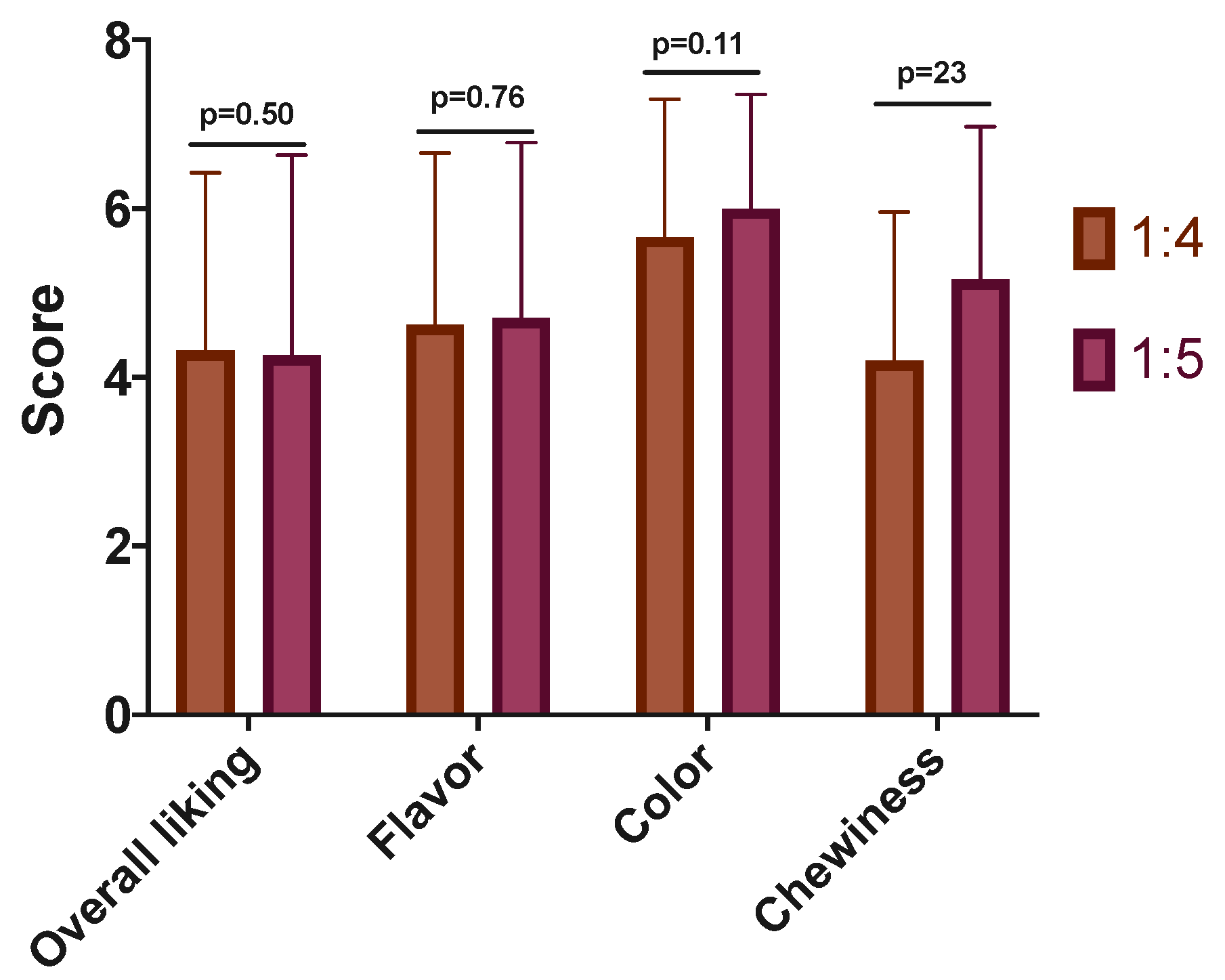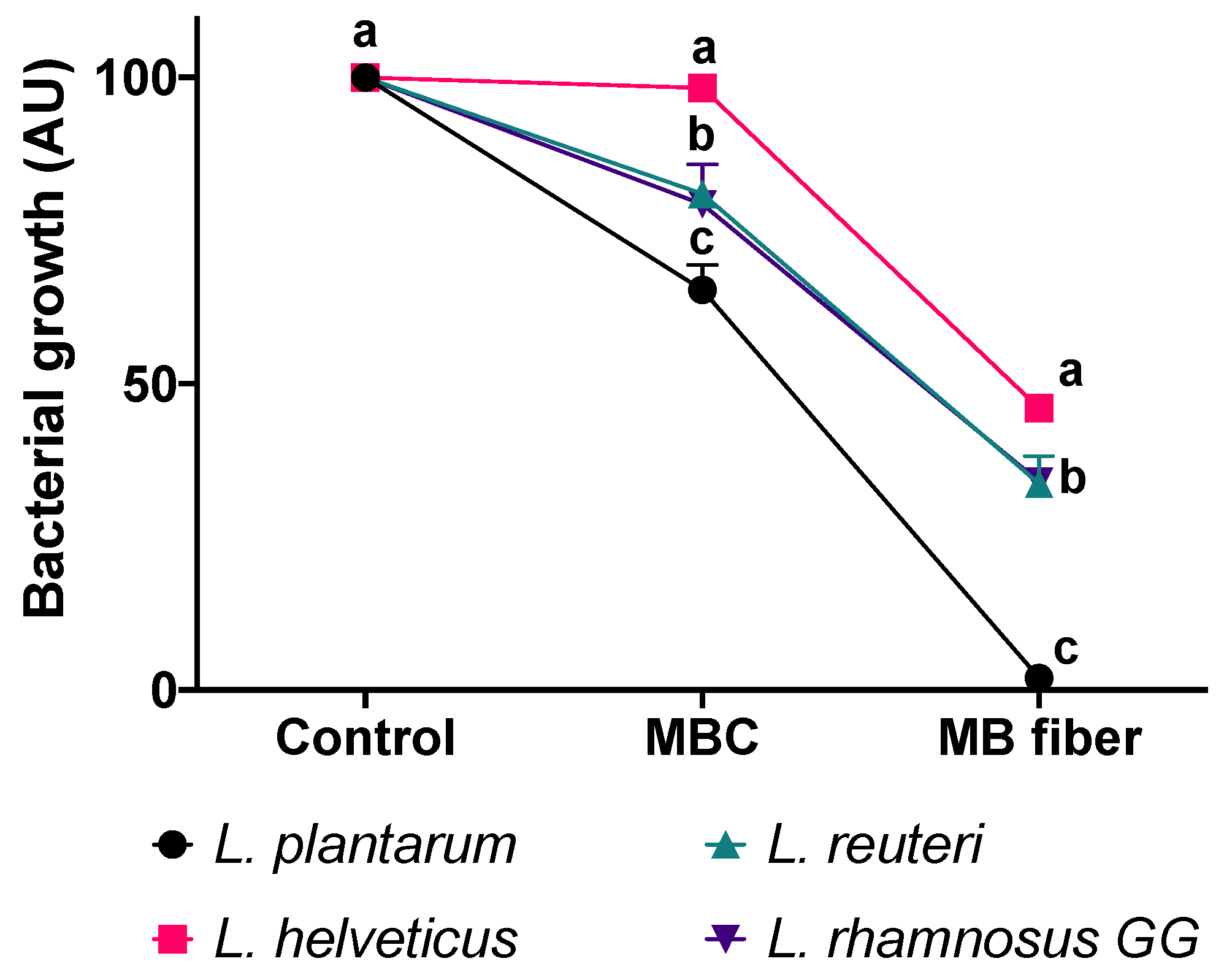Mango (Mangifera indica L.) Bagasse-Added Gum Confections Are a Source of Bioactive Compounds Exhibiting Prebiotic Effects In Vitro †
Abstract
1. Introduction
2. Materials and Methods
2.1. Biological Materials and Confection Manufacturing
2.2. Texture Profile Analyses (TPA) and Sensory Study
2.3. Proximal and Nutraceutical Composition of 1:4 Formulation
2.4. Prebiotic Effect In Vitro
2.5. Statistical Analysis
3. Results and Discussion
3.1. Texture Profile and Sensory Study for the 1:4 and 1:5 MB:Water Formulations
3.2. Proximal and Nutraceutical Composition of MB-Added Formulations
3.3. Prebiotic Effect In Vitro
4. Conclusions
Author Contributions
Funding
Institutional Review Board Statement
Informed Consent Statement
Data Availability Statement
Acknowledgments
Conflicts of Interest
References
- Weihrauch-Blüher, S.; Schwarz, P.; Klusmann, J.-H. Childhood Obesity: Increased Risk for Cardiometabolic Disease and Cancer in Adulthood. Metabolism 2019, 92, 147–152. [Google Scholar] [CrossRef] [PubMed]
- Aburto, T.C.; Pedraza, L.S.; Sánchez-Pimienta, T.G.; Batis, C.; Rivera, J.A. Discretionary Foods Have a High Contribution and Fruit, Vegetables, and Legumes Have a Low Contribution to the Total Energy Intake of the Mexican Population. J. Nutr. 2016, 146, 1881S–1887S. [Google Scholar] [CrossRef] [PubMed]
- Herrera-Cazares, L.A.; Hernandez-Navarro, F.; Ramirez-Jimenez, A.K.; Campos-Vega, R.R.; de la Luz Reyes-Vega, M.; Loarca-Pina, G.; Morales-Sanchez, E.; Wall-Medrano, A.; Gaytan-Martinez, M.; Hernández-Navarro, F.; et al. Mango-Bagasse Functional-Confectionery: Vehicle for Enhancing Bioaccessibility and Permeability of Phenolic Compounds. Food Funct. 2017, 8, 3906–3916. [Google Scholar] [CrossRef] [PubMed]
- Herrera-Cazares, L.A.; Ramírez-Jiménez, A.K.; Luzardo-Ocampo, I.; Antunes-Ricardo, M.; Loarca-Piña, G.; Wall-Medrano, A.; Gaytán-Martínez, M. Gastrointestinal Metabolism of Monomeric and Polymeric Polyphenols from Mango (Mangifera indica L.) Bagasse under Simulated Conditions. Food Chem. 2021, 365, 130528. [Google Scholar] [CrossRef] [PubMed]
- Herrera-Cazares, L.A.; Ramírez-Jiménez, A.K.; Wall-Medrano, A.; Campos-Vega, R.; Loarca-Piña, G.; Reyes-Vega, M.L.; Vázquez-Landaverde, P.A.; Gaytán-Martínez, M. Untargeted Metabolomic Evaluation of Mango Bagasse and Mango Bagasse Based Confection under in Vitro Simulated Colonic Fermentation. J. Funct. Foods 2019, 54, 271–280. [Google Scholar] [CrossRef]
- Ajila, C.M.; Brar, S.K.; Verma, M.; Tyagi, R.D.; Godbout, S.; Valéro, J.R. Bio-Processing of Agro-Byproducts to Animal Feed. Crit. Rev. Biotechnol. 2012, 32, 382–400. [Google Scholar] [CrossRef] [PubMed]
- Sanon, H.; Kanwe, A. Valorisation of Mango Peels and Seed Kernels in Animal Feeding: Nutritive Value and Voluntary Feed Intake by Sheep. Adv. Anim. Biosci. 2010, 1, 445–446. [Google Scholar] [CrossRef]
- Herrera-Cazares, L.A.; Luzardo-Ocampo, I.; Ramírez-Jiménez, A.K.; Gutiérrez-Uribe, J.A.; Campos-Vega, R.; Gaytán-Martínez, M. Influence of Extrusion Process on the Release of Phenolic Compounds from Mango (Mangifera indica L.) Bagasse-Added Confections and Evaluation of Their Bioaccessibility, Intestinal Permeability, and Antioxidant Capacity. Food Res. Int. 2021, 148, 110591. [Google Scholar] [CrossRef]
- Corrigan, V.K.; Hedderley, D.I.; Hurst, P.L. Assessment of Objective Texture Measurements for Characterising and Predicting the Sensory Quality of Squash (Cucurbita maxima). N. Z. J. Crop Hortic. Sci. 2006, 34, 369–379. [Google Scholar] [CrossRef][Green Version]
- AOAC. Official Methods of Analysis of AOAC International, 7th ed.; Horwitz, W., Latimer, G.W., Eds.; AOAC International: Gaithersburg, MD, USA, 2002; ISBN 0-935584-77-3. [Google Scholar]
- Ramírez-Jiménez, A.K.; Reynoso-Camacho, R.; Mendoza-Díaz, S.; Loarca-Piña, G. Functional and Technological Potential of Dehydrated Phaseolus Vulgaris L. Flours. Food Chem. 2014, 161, 254–260. [Google Scholar] [CrossRef] [PubMed]
- Pacheco-Ordaz, R.; Wall-Medrano, A.; Goñi, M.G.; Ramos-Clamont-Montfort, G.; Ayala-Zavala, J.F.; González-Aguilar, G.A. Effect of Phenolic Compounds on the Growth of Selected Probiotic and Pathogenic Bacteria. Lett. Appl. Microbiol. 2018, 66, 25–31. [Google Scholar] [CrossRef] [PubMed]
- Aranda-González, I.; Tamayo-Dzul, O.; Barbosa-Martín, E.; Segura-Campos, M.; Moguel-Ordoñez, Y.; Betancur-Acona, D.; Tamayo-Dzul, Ó.; Barbosa-Martín, E.; Segura-Campos, M.; Moguel-Ordoñez, Y.; et al. Development of a Gummy Candy Reduced in Calories by Sugar Substitution with Stevia Rebaudiana B. Nutr. Hosp. 2015, 31, 334–340. [Google Scholar] [CrossRef]
- Hernández-Maldonado, L.M.; Blancas-Benítez, F.J.; Zamora-Gasga, V.M.; Cárdenas-Castro, A.P.; Tovar, J.; Sáyago-Ayerdi, S.G. In Vitro Gastrointestinal Digestion and Colonic Fermentation of High Dietary Fiber and Antioxidant-Rich Mango (Mangifera Indica L.) “Ataulfo”-Based Fruit Bars. Nutrients 2019, 11, 1564. [Google Scholar] [CrossRef] [PubMed]


| Formulations | Hardness (N) | Cohesiveness (g) | Springiness (mm) | Chewiness (N × cm) |
|---|---|---|---|---|
| 1:4 | 14.57 ± 2.08 a | 0.74 ± 0.03 a | 3.60 ± 0.21 b | 14.57 ± 2.08 a |
| 1:5 | 11.13 ± 0.73 a | 0.80 ± 0.05 a | 3.48 ± 0.31 b | 11.14 ± 0.73 b |
| C1 | 1.88 ± 0.28 b | 0.90 ± 0.04 a | 4.99 ± 0.23 a | 1.89 ± 0.28 c |
| Parameter | Value | |
|---|---|---|
| Proximal composition 1 | Moisture | 25.60 ± 2.40 |
| Protein | 4.40 ± 1.10 | |
| Ash | 0.50 ± 0.00 | |
| Lipids | 0.20 ± 0.01 | |
| Carbohydrates | 58.80 ± 4.20 | |
| Nutraceutical composition | TDF | 10.50 ± 2.10 |
| SDF | 7.10 ± 1.50 | |
| IDF | 3.40 ± 0.70 | |
| Gallic acid 2 | 716.11 ± 0.11 | |
| Mangiferin 2 | 1377.29 ± 0.10 | |
| Quercetin 2 | n.d. | |
| (+)-catechin 2 | 1093.01 ± 0.43 | |
Publisher’s Note: MDPI stays neutral with regard to jurisdictional claims in published maps and institutional affiliations. |
© 2021 by the authors. Licensee MDPI, Basel, Switzerland. This article is an open access article distributed under the terms and conditions of the Creative Commons Attribution (CC BY) license (https://creativecommons.org/licenses/by/4.0/).
Share and Cite
Flores-Zavala, D.; Luzardo-Ocampo, I.; Olivas-Aguirre, F.J.; Wall-Medrano, A.; Loarca-Piña, G.; Andrade, J.E.; Gaytán-Martínez, M. Mango (Mangifera indica L.) Bagasse-Added Gum Confections Are a Source of Bioactive Compounds Exhibiting Prebiotic Effects In Vitro. Biol. Life Sci. Forum 2021, 6, 94. https://doi.org/10.3390/Foods2021-10995
Flores-Zavala D, Luzardo-Ocampo I, Olivas-Aguirre FJ, Wall-Medrano A, Loarca-Piña G, Andrade JE, Gaytán-Martínez M. Mango (Mangifera indica L.) Bagasse-Added Gum Confections Are a Source of Bioactive Compounds Exhibiting Prebiotic Effects In Vitro. Biology and Life Sciences Forum. 2021; 6(1):94. https://doi.org/10.3390/Foods2021-10995
Chicago/Turabian StyleFlores-Zavala, Daniela, Ivan Luzardo-Ocampo, Francisco J. Olivas-Aguirre, Abraham Wall-Medrano, Guadalupe Loarca-Piña, Juan E. Andrade, and Marcela Gaytán-Martínez. 2021. "Mango (Mangifera indica L.) Bagasse-Added Gum Confections Are a Source of Bioactive Compounds Exhibiting Prebiotic Effects In Vitro" Biology and Life Sciences Forum 6, no. 1: 94. https://doi.org/10.3390/Foods2021-10995
APA StyleFlores-Zavala, D., Luzardo-Ocampo, I., Olivas-Aguirre, F. J., Wall-Medrano, A., Loarca-Piña, G., Andrade, J. E., & Gaytán-Martínez, M. (2021). Mango (Mangifera indica L.) Bagasse-Added Gum Confections Are a Source of Bioactive Compounds Exhibiting Prebiotic Effects In Vitro. Biology and Life Sciences Forum, 6(1), 94. https://doi.org/10.3390/Foods2021-10995









